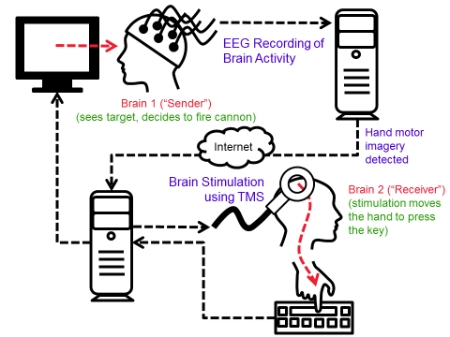
Engineers create first human “mind meld” over the Internet
Mike McLeod
General research and development University of WashingtonBrain-To-Brain Interface allows researcher to control colleague’s hand motion.

University of Washington researcher Rajesh Rao, left, plays a computer game with his mind. Across campus, researcher Andrea Stocco, right, wears a magnetic stimulation coil over the left motor cortex region of his brain. Stocco’s right index finger moved involuntarily to hit the “fire” button as part of the first human brain-to-brain interface demonstration. (University of Washington).
“The Internet was a way to connect computers, and now it can be a way to connect brains,” Stocco said. “We want to take the knowledge of a brain and transmit it directly from brain to brain.”
To conduct the experiment, Rao wore a cap with electrodes hooked up to an electroencephalography machine and played a simple video game with his mind. At the same time, Stocco wore a transcranial magnetic stimulation coil placed directly over his left motor cortex, which controls hand movement. Rao imagined moving his right hand, causing a cursor to hit the “fire” button. According to the researchers, Stocco involuntarily moved his right index finger to push the space bar on the keyboard in front of him, almost instantaneously.
“It was both exciting and eerie to watch an imagined action from my brain get translated into actual action by another brain,” Rao said. “This was basically a one-way flow of information from my brain to his. The next step is having a more equitable two-way conversation directly between the two brains.”
 The technologies used by the researchers for recording and stimulating the brain are both well-known. Electroencephalography, or EEG, is routinely used by clinicians and researchers to record brain activity noninvasively from the scalp. Transcranial magnetic stimulation is a noninvasive way of delivering stimulation to the brain. Its effect depends on where the coil is placed; in this case, it was placed directly over the brain region that controls a person’s right hand.
The technologies used by the researchers for recording and stimulating the brain are both well-known. Electroencephalography, or EEG, is routinely used by clinicians and researchers to record brain activity noninvasively from the scalp. Transcranial magnetic stimulation is a noninvasive way of delivering stimulation to the brain. Its effect depends on where the coil is placed; in this case, it was placed directly over the brain region that controls a person’s right hand.
Rao and Stocco say they plan to conduct an experiment that would transmit more complex information from one brain to the other. If that works, they then will conduct the experiment on a larger pool of subjects.
Their research was funded in part by the National Science Foundation’s Engineering Research Center for Sensorimotor Neural Engineering at the UW, the U.S. Army Research Office and the National Institutes of Health.
www.washington.edu
